Calmodulin Binding to Connexin 35: Specializations to Function as an Electrical Synapse
Abstract
1. Introduction
2. Results
2.1. Identification of Calmodulin Binding Sites in Connexin 35
2.2. Mutational Analysis of the Cx35 C-Terminal Calmodulin Binding Site
2.3. Does Calmodulin Binding Uncouple Cx35 Gap Junctions?
2.4. Does Calmodulin Binding to Cx35 Influence CaM Kinase-Mediated Potentiation?
2.5. Do Calmodulin Binding Sites Affect Protein Trafficking?
3. Discussion
3.1. Calmodulin Binding Uncouples Cx35 Gap Junctions
3.2. Competition between Calmodulin Uncoupling and CaMKII Potentiation
3.3. Does Calmodulin Binding Play A Role in Cx35 Trafficking?
3.4. A Nexus for Functional Regulation
3.5. Limitations of This Study
4. Materials and Methods
4.1. Clones
4.2. Surface Plasmon Resonance Studies
4.3. Tracer Coupling Studies
4.4. Ratiometric Calcium Measurements
4.5. Immunofluorescence Imaging
4.6. Statistical Analyses
Supplementary Materials
Author Contributions
Funding
Acknowledgments
Conflicts of Interest
Abbreviations
| MDPI | Multidisciplinary Digital Publishing Institute |
| DOAJ | Directory of open access journals |
| CaMKII | Calmodulin-dependent protein kinase II |
| Cx35 | Connexin 35 (gjd2b) |
| Cx36 | Connexin 36 (gjd2) |
| EGTA | Ethylene glycol-bis(2-aminoethylether)-N,N,N′,N′-tetraacetic acid |
| GST | Glutathione S-transferase |
| HEDTA | N-(2-Hydroxyethyl)ethylenediamine-N,N′,N′-triacetic acid |
| HEPES | N-(2-Hydroxyethyl)piperazine-N′-(2-ethanesulfonic acid) |
| MEM | Minimal essential medium |
| MOPS | 3-(N-morpholino)propanesulfonic acid |
| NTA | Nitrilotriacetic acid |
| W7 | N-(6-Aminohexyl)-1-naphthalenesulfonamide hydrochloride |
References
- Sáez, J.C.; Berthoud, V.M.; Brañes, M.C.; Martínez, A.D.; Beyer, E. Plasma Membrane Channels Formed by Connexins: Their Regulation and Functions. Physiol. Rev. 2003, 83, 1359–1400. [Google Scholar] [CrossRef] [PubMed]
- Decrock, E.; Vinken, M.; De Vuyst, E.; Krysko, D.V.; D’Herde, K.; Vanhaecke, T.; Vandenabeele, P.; Rogiers, V.; Leybaert, L. Connexin-related signaling in cell death: To live or let die? Cell Death Differ. 2009, 16, 524–536. [Google Scholar] [CrossRef] [PubMed]
- Bagur, R.; Hajnóczky, G. Intracellular Ca2+ Sensing: Its Role in Calcium Homeostasis and Signaling. Mol. Cell 2017, 66, 780–788. [Google Scholar] [CrossRef] [PubMed]
- Harr, M.W.; Distelhorst, C.W. Apoptosis and Autophagy: Decoding Calcium Signals that Mediate Life or Death. Cold Spring Harb. Perspect. Boil. 2010, 2, a005579. [Google Scholar] [CrossRef]
- Baux, G.; Simonneau, M.; Tauc, L.; Segundo, J.P. Uncoupling of electrotonic synapses by calcium. Proc. Natl. Acad. Sci. USA 1978, 75, 4577–4581. [Google Scholar] [CrossRef]
- Peracchia, C. Calcium effects on gap junction structure and cell coupling. Nature 1978, 271, 669–671. [Google Scholar] [CrossRef]
- Peracchia, C. Chemical gating of gap junction channels; roles of calcium, pH and calmodulin. Biochim. Biophys Acta. 2004, 1662, 61–80. [Google Scholar] [CrossRef]
- Peracchia, C. Calmodulin-Mediated Regulation of Gap Junction Channels. Int. J. Mol. Sci. 2020, 21, 485. [Google Scholar] [CrossRef]
- Zou, J.; Salarian, M.; Chen, Y.; Veenstra, R.; Louis, C.F.; Yang, J.J. Gap junction regulation by calmodulin. FEBS Lett. 2014, 588, 1430–1438. [Google Scholar] [CrossRef]
- Söhl, G.; Degen, J.; Teubner, B.; Willecke, K. The murine gap junction gene connexin36 is highly expressed in mouse retina and regulated during brain development. FEBS Lett. 1998, 428, 27–31. [Google Scholar] [CrossRef]
- Abascal, F.; Zardoya, R. Evolutionary analyses of gap junction protein families. Biochim. Biophys. Acta (BBA) Biomembr. 2013, 1828, 4–14. [Google Scholar] [CrossRef]
- O’Brien, J.; Al-Ubaidi, M.R.; Ripps, H. Connexin 35: A gap-junctional protein expressed preferentially in the skate retina. Mol. Boil. Cell 1996, 7, 233–243. [Google Scholar] [CrossRef] [PubMed][Green Version]
- O’Brien, J.; Bruzzone, R.; White, T.W.; Al-Ubaidi, M.R.; Ripps, H. Cloning and Expression of Two Related Connexins from the Perch Retina Define a Distinct Subgroup of the Connexin Family. J. Neurosci. 1998, 18, 7625–7637. [Google Scholar] [CrossRef] [PubMed]
- Condorelli, D.F.; Parenti, R.; Spinella, F.; Trovato-Salinaro, A.; Belluardo, N.; Cardile, V.; Cicirata, F. Cloning of a new gap junction gene (Cx36) highly expressed in mammalian brain neurons. Eur. J. Neurosci. 1998, 10, 1202–1208. [Google Scholar] [CrossRef] [PubMed]
- Belluardo, N.; Mudo, G.; Trovato-Salinaro, A.; Le Gurun, S.; Charollais, A.; Serre-Beinier, V.; Amato, G.; Haefliger, J.A.; Meda, P.; Condorelli, D.F. Expression of connexin36 in the adult and developing rat brain. Brain Res. 2000, 865, 121–138. [Google Scholar] [CrossRef]
- Rash, J.E.; Staines, W.A.; Yasumura, T.; Patel, D.; Furman, C.S.; Stelmack, G.L.; Nagy, J.I. Immunogold evidence that neuronal gap junctions in adult rat brain and spinal cord contain connexin-36 but not connexin-32 or connexin-43. Proc. Natl. Acad. Sci. USA 2000, 97, 7573–7578. [Google Scholar] [CrossRef]
- Serre-Beinier, V.; Le Gurun, S.; Belluardo, N.; Trovato-Salinaro, A.; Charollais, A.; Haefliger, J.A.; Condorelli, D.F.; Meda, P. Cx36 preferentially connects beta-cells within pancreatic islets. Diabetes 2000, 49, 727–734. [Google Scholar] [CrossRef]
- Curti, S.; O’Brien, J. Characteristics and plasticity of electrical synaptic transmission. BMC Cell Boil. 2016, 17, 13. [Google Scholar] [CrossRef]
- O’Brien, J. Design principles of electrical synaptic plasticity. Neurosci. Lett. 2019, 695, 4–11. [Google Scholar] [CrossRef]
- Burr, G.S.; Mitchell, C.K.; Keflemariam, Y.J.; Heidelberger, R.; O’Brien, J. Calcium-dependent binding of calmodulin to neuronal gap junction proteins. Biochem. Biophys. Res. Commun. 2005, 335, 1191–1198. [Google Scholar] [CrossRef][Green Version]
- Siu, R.C.F.; Smirnova, E.; Brown, C.A.; Zoidl, C.; Spray, D.C.; Donaldson, L.; Zoidl, G. Structural and Functional Consequences of Connexin 36 (Cx36) Interaction with Calmodulin. Front. Mol. Neurosci. 2016, 9, 120. [Google Scholar] [CrossRef] [PubMed]
- Peracchia, C.; Sotkis, A.; Wang, X.G.; Peracchia, L.L.; Persechini, A. Calmodulin Directly Gates Gap Junction Channels. J. Boil. Chem. 2000, 275, 26220–26224. [Google Scholar] [CrossRef] [PubMed]
- Yap, K.L.; Kim, J.; Truong, K.; Sherman, M.; Yuan, T.; Ikura, M. Calmodulin Target Database. J. Struct. Funct. Genom. 2000, 1, 8–14. [Google Scholar] [CrossRef] [PubMed]
- Alev, C.; Urschel, S.; Sonntag, S.; Zoidl, G.; Fort, A.G.; Höher, T.; Matsubara, M.; Willecke, K.; Spray, D.C.; Dermietzel, R. The neuronal connexin36 interacts with and is phosphorylated by CaMKII in a way similar to CaMKII interaction with glutamate receptors. Proc. Natl. Acad. Sci. USA 2008, 105, 20964–20969. [Google Scholar] [CrossRef]
- Rhoads, A.R.; Friedberg, F. Sequence motifs for calmodulin recognition. FASEB J. 1997, 11, 331–340. [Google Scholar] [CrossRef]
- Mruk, K.; Farley, B.M.; Ritacco, A.W.; Kobertz, W.R. Calmodulation meta-analysis: Predicting calmodulin binding via canonical motif clustering. J. Gen. Physiol. 2014, 144, 105–114. [Google Scholar] [CrossRef]
- Bähler, M.; Rhoads, A. Calmodulin signaling via the IQ motif. FEBS Lett. 2002, 513, 107–113. [Google Scholar] [CrossRef]
- O’Brien, J.; Nguyen, H.B.; Mills, S.L. Cone photoreceptors in bass retina use two connexins to mediate electrical coupling. J. Neurosci. 2004, 24, 5632–5642. [Google Scholar] [CrossRef]
- Ouyang, X.; Winbow, V.M.; Patel, L.S.; Burr, G.S.; Mitchell, C.K.; O’Brien, J. Protein kinase A mediates regulation of gap junctions containing connexin35 through a complex pathway. Mol. Brain Res. 2005, 135, 1–11. [Google Scholar] [CrossRef]
- Aseervatham, J.; Yoshikawa, S.; Nguyen, D.M.; Mitchell, C.K.; Lin, Y.-P.; O’Brien, J. Plasma membrane trafficking of Connexin 35 in HeLa cells is facilitated by the expression of endogenous connexins. submitted.
- Moore, K.B.; Mitchell, C.K.; Lin, Y.-P.; Lee, Y.-H.; Shihabeddin, E.; O’Brien, J. Localized Calcium Signaling and the Control of Coupling at Cx36 Gap Junctions. Eneuro 2020, 7. [Google Scholar] [CrossRef]
- Kothmann, W.W.; Trexler, E.B.; Whitaker, C.M.; Li, W.; Massey, S.C.; O’Brien, J. Nonsynaptic NMDA receptors mediate activity-dependent plasticity of gap junctional coupling in the AII amacrine cell network. J. Neurosci. 2012, 32, 6747–6759. [Google Scholar] [CrossRef] [PubMed]
- Del Corsso, C.; Iglesias, R.; Zoidl, G.; Dermietzel, R.; Spray, D.C. Calmodulin dependent protein kinase increases conductance at gap junctions formed by the neuronal gap junction protein connexin36. Brain Res. 2012, 1487, 69–77. [Google Scholar] [CrossRef] [PubMed]
- Ahmad, S.; Martin, P.E.M.; Evans, W.H. Assembly of gap junction channels: Mechanism, effects of calmodulin antagonists and identification of connexin oligomerization determinants. Eur. J. Biochem. 2001, 268, 4544–4552. [Google Scholar] [CrossRef] [PubMed]
- Eastman, S.D.; Chen, T.H.-P.; Falk, M.M.; Mendelson, T.C.; Iovine, M.K. Phylogenetic analysis of three complete gap junction gene families reveals lineage-specific duplications and highly supported gene classes. Genomics 2006, 87, 265–274. [Google Scholar] [CrossRef] [PubMed]
- Cruciani, V.; Mikalsen, S.-O. The vertebrate connexin family. Cell. Mol. Life Sci. 2006, 63, 1125–1140. [Google Scholar] [CrossRef]
- Srinivas, M.; Rozental, R.; Kojima, T.; Dermietzel, R.; Mehler, M.; Condorelli, D.F.; Kessler, J.A.; Spray, D.C. Functional Properties of Channels Formed by the Neuronal Gap Junction Protein Connexin36. J. Neurosci. 1999, 19, 9848–9855. [Google Scholar] [CrossRef]
- Al-Ubaidi, M.R.; White, T.W.; Ripps, H.; Poras, I.; Avner, P.; Gomes, D.; Bruzzone, R. Functional properties, developmental regulation, and chromosomal localization of murine connexin36, a gap-junctional protein expressed preferentially in retina and brain. J. Neurosci. Res. 2000, 59, 813–826. [Google Scholar] [CrossRef]
- Valiunas, V.; Mui, R.; McLachlan, E.; Valdimarsson, G.; Brink, P.R.; White, T.W. Biophysical characterization of zebrafish connexin35 hemichannels. Am. J. Physiol. Physiol. 2004, 287, C1596–C1604. [Google Scholar] [CrossRef]
- Mills, S.L.; Massey, S.C. The kinetics of tracer movement through homologous gap junctions in the rabbit retina. Vis. Neurosci. 1998, 15, 765–777. [Google Scholar] [CrossRef]
- Zhou, Y.; Yang, W.; Lurtz, M.M.; Chen, Y.; Jiang, J.; Huang, Y.; Louis, C.F.; Yang, J.J. Calmodulin Mediates the Ca2+-Dependent Regulation of Cx44 Gap Junctions. Biophys. J. 2009, 96, 2832–2848. [Google Scholar] [CrossRef]
- Chen, Y.; Zhou, Y.; Lin, X.; Wong, H.; Xu, Q.; Jiang, J.; Wang, S.; Lurtz, M.M.; Louis, C.F.; Veenstra, R.D.; et al. Molecular interaction and functional regulation of connexin50 gap junctions by calmodulin. Biochem. J. 2011, 435, 711–722. [Google Scholar] [CrossRef]
- Xu, Q.; Kopp, R.F.; Chen, Y.; Yang, J.J.; Roe, M.W.; Veenstra, R.D. Gating of connexin 43 gap junctions by a cytoplasmic loop calmodulin binding domain. Am. J. Physiol. Physiol. 2012, 302, C1548–C1556. [Google Scholar] [CrossRef] [PubMed]
- Wei, S.; Cassara, C.; Lin, X.; Veenstra, R.D. Calcium–calmodulin gating of a pH-insensitive isoform of connexin43 gap junctions. Biochem. J. 2019, 476, 1137–1148. [Google Scholar] [CrossRef] [PubMed]
- Lurtz, M.M.; Louis, C.F. Intracellular calcium regulation of connexin43. Am. J. Physiol. Physiol. 2007, 293, C1806–C1813. [Google Scholar] [CrossRef] [PubMed]
- Pereda, A.E. Electrical synapses and their functional interactions with chemical synapses. Nat. Rev. Neurosci. 2014, 15, 250–263. [Google Scholar] [CrossRef]
- Nagy, J.I.; Pereda, A.E.; Rash, J.E. On the occurrence and enigmatic functions of mixed (chemical plus electrical) synapses in the mammalian CNS. Neurosci. Lett. 2019, 695, 53–64. [Google Scholar] [CrossRef]
- Turecek, J.; Yuen, G.S.; Han, V.Z.; Zeng, X.H.; Bayer, K.U.; Welsh, J.P. NMDA receptor activation strengthens weak electrical coupling in mammalian brain. Neuron 2014, 81, 1375–1388. [Google Scholar] [CrossRef][Green Version]
- Shifman, J.M.; Choi, M.H.; Mihalas, S.; Mayo, S.L.; Kennedy, M.B. Ca2+/calmodulin-dependent protein kinase II (CaMKII) is activated by calmodulin with two bound calciums. Proc. Natl. Acad. Sci. USA 2006, 103, 13968–13973. [Google Scholar] [CrossRef]
- Putkey, J.A.; Waxham, M.N. A Peptide Model for Calmodulin Trapping by Calcium/Calmodulin-dependent Protein Kinase II. J. Boil. Chem. 1996, 271, 29619–29623. [Google Scholar] [CrossRef]
- Lisman, J.; Schulman, H.; Cline, H. The molecular basis of CaMKII function in synaptic and behavioural memory. Nat. Rev. Neurosci. 2002, 3, 175–190. [Google Scholar] [CrossRef]
- Pereda, A.E.; Curti, S.; Hoge, G.; Cachope, R.; Flores, C.E.; Rash, J.E. Gap junction-mediated electrical transmission: Regulatory mechanisms and plasticity. Biochim. Biophys. Acta (BBA) Biomembr. 2013, 1828, 134–146. [Google Scholar] [CrossRef] [PubMed]
- O’Brien, J. The ever-changing electrical synapse. Curr. Opin. Neurobiol. 2014, 29, 64–72. [Google Scholar] [CrossRef] [PubMed]
- Brown, C.A.; del Corsso, C.; Zoidl, C.; Donaldson, L.W.; Spray, D.C.; Zoidl, G. Tubulin-Dependent Transport of Connexin-36 Potentiates the Size and Strength of Electrical Synapses. Cells 2019, 8, 1146. [Google Scholar] [CrossRef] [PubMed]
- Urschel, S.; Höher, T.; Schubert, T.; Alev, C.; Söhl, G.; Wörsdörfer, P.; Asahara, T.; Dermietzel, R.; Weiler, R.; Willecke, K. Protein Kinase A-mediated Phosphorylation of Connexin36 in Mouse Retina Results in Decreased Gap Junctional Communication between AII Amacrine Cells. J. Boil. Chem. 2006, 281, 33163–33171. [Google Scholar] [CrossRef] [PubMed]
- Patel, L.S.; Mitchell, C.K.; Dubinsky, W.P.; O’Brien, J. Regulation of Gap Junction Coupling Through the Neuronal Connexin Cx35 by Nitric Oxide and cGMP. Cell Commun. Adhes. 2006, 13, 41–54. [Google Scholar] [CrossRef]
- Li, L.; Shi, X.; Guo, X.; Li, H.; Xu, C. Ionic protein–lipid interaction at the plasma membrane: What can the charge do? Trends Biochem. Sci. 2014, 39, 130–140. [Google Scholar] [CrossRef]
- Shi, X.; Bi, Y.; Yang, W.; Guo, X.; Jiang, Y.; Wan, C.; Li, L.; Bai, Y.; Guo, J.; Wang, Y.; et al. Ca2+ regulates T-cell receptor activation by modulating the charge property of lipids. Nature 2012, 493, 111–115. [Google Scholar] [CrossRef]
- Maeda, S.; Nakagawa, S.; Suga, M.; Yamashita, E.; Oshima, A.; Fujiyoshia, Y.; Tsukihara, T. Structure of the connexin 26 gap junction channel at 3.5 Å resolution. Nature 2009, 458, 597–602. [Google Scholar] [CrossRef]
- Peracchia, C.; Wang, X.; Peracchia, L. Slow gating of gap junction channels and calmodulin. J. Membr. Boil. 2000, 178, 55–70. [Google Scholar] [CrossRef]
- Peracchia, C. Calmodulin-Cork Model of Gap Junction Channel Gating—One Molecule, Two Mechanisms. Int. J. Mol. Sci. 2020, 21, 4938. [Google Scholar] [CrossRef]
- Zhang, X.; Qi, Y. Role of intramolecular interaction in connexin50: Mediating the Ca2+-dependent binding of calmodulin to gap junction. Arch. Biochem. Biophys. 2005, 440, 111–117. [Google Scholar] [CrossRef] [PubMed]
- Dodd, R.; Peracchia, C.; Stolady, D.; Török, K. Calmodulin Association with Connexin32-derived Peptides Suggeststrans-Domain Interaction in Chemical Gating of Gap Junction Channels. J. Boil. Chem. 2008, 283, 26911–26920. [Google Scholar] [CrossRef] [PubMed]
- Gaertner, T.R.; Putkey, J.A.; Waxham, M.N. RC3/Neurogranin and Ca2+/calmodulin-dependent protein kinase II produce opposing effects on the affinity of calmodulin for calcium. J. Biol. Chem. 2004, 279, 39374–39382. [Google Scholar] [CrossRef] [PubMed]
- Messler, P.; Harz, H.; Uhl, R. Instrumentation for multiwavelengths excitation imaging. J. Neurosci. Methods 1996, 69, 137–147. [Google Scholar] [CrossRef]
- Frazao, R.; McMahon, U.G.; Schunack, W.; Datta, P.; Heidelberger, R.; Marshak, D.W. Histamine elevates free intracellular calcium in mouse retinal dopaminergic cells via H1-receptors. Investig. Opthalmology Vis. Sci. 2011, 52, 3083–3088. [Google Scholar] [CrossRef] [PubMed][Green Version]
- Grynkiewicz, G.; Poenie, M.; Tsien, R.Y. A new generation of Ca2+ indicators with greatly improved fluorescence properties. J. Boil. Chem. 1985, 260, 3440–3450. [Google Scholar]
- Heidelberger, R.; Matthews, G. Calcium influx and calcium current in single synaptic terminals of goldfish retinal bipolar neurons. J. Physiol. 1992, 447, 235–256. [Google Scholar] [CrossRef]
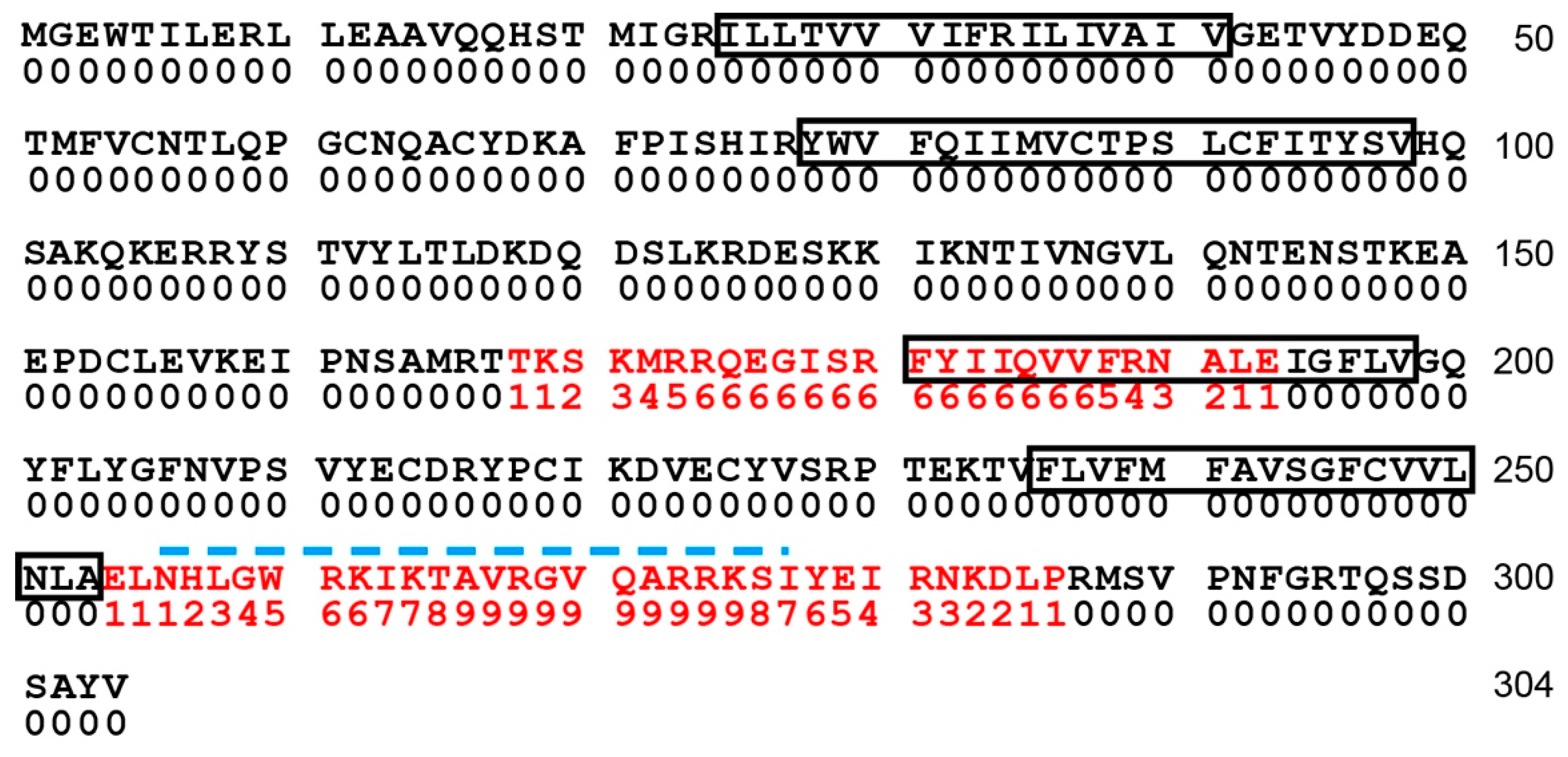

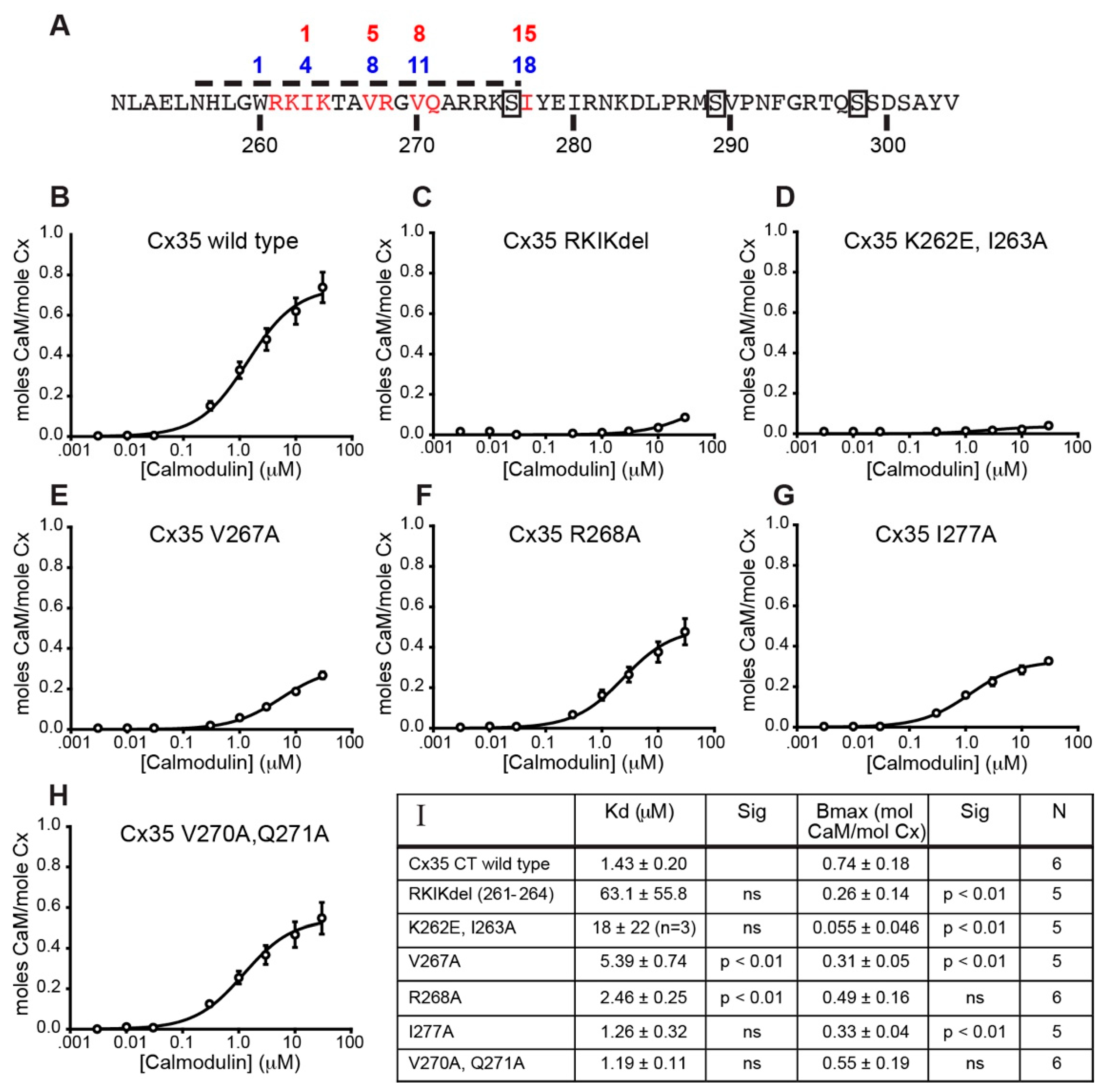
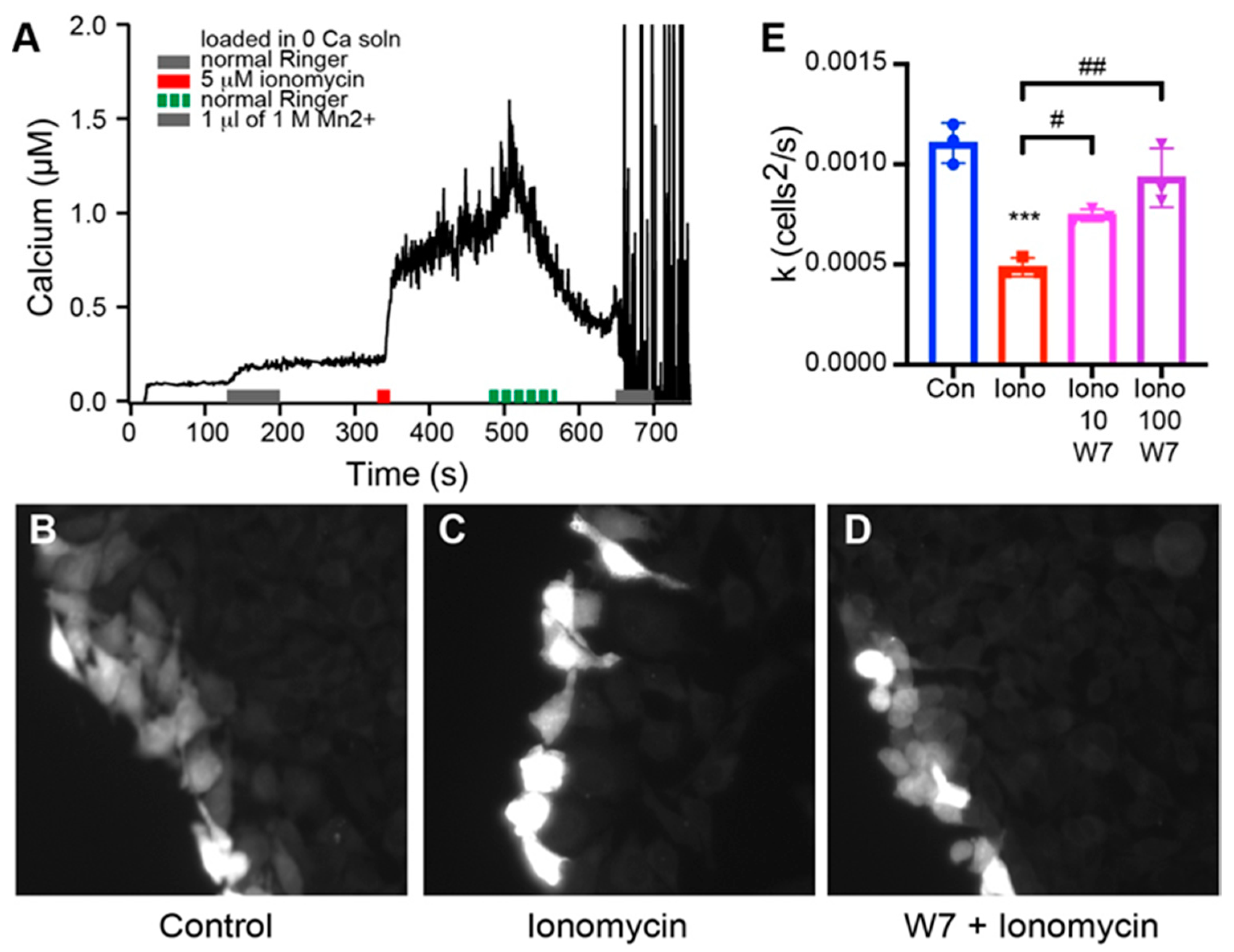
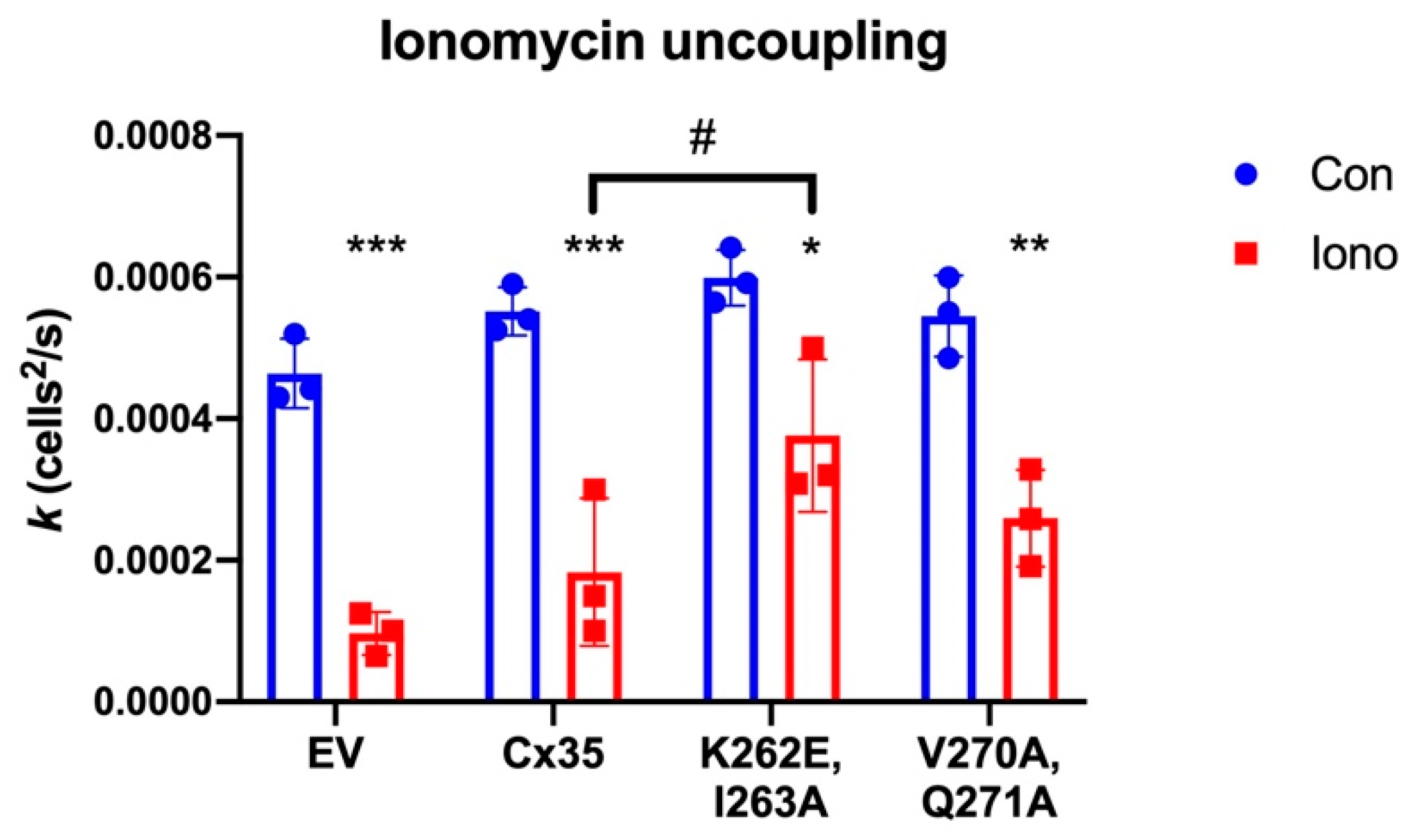
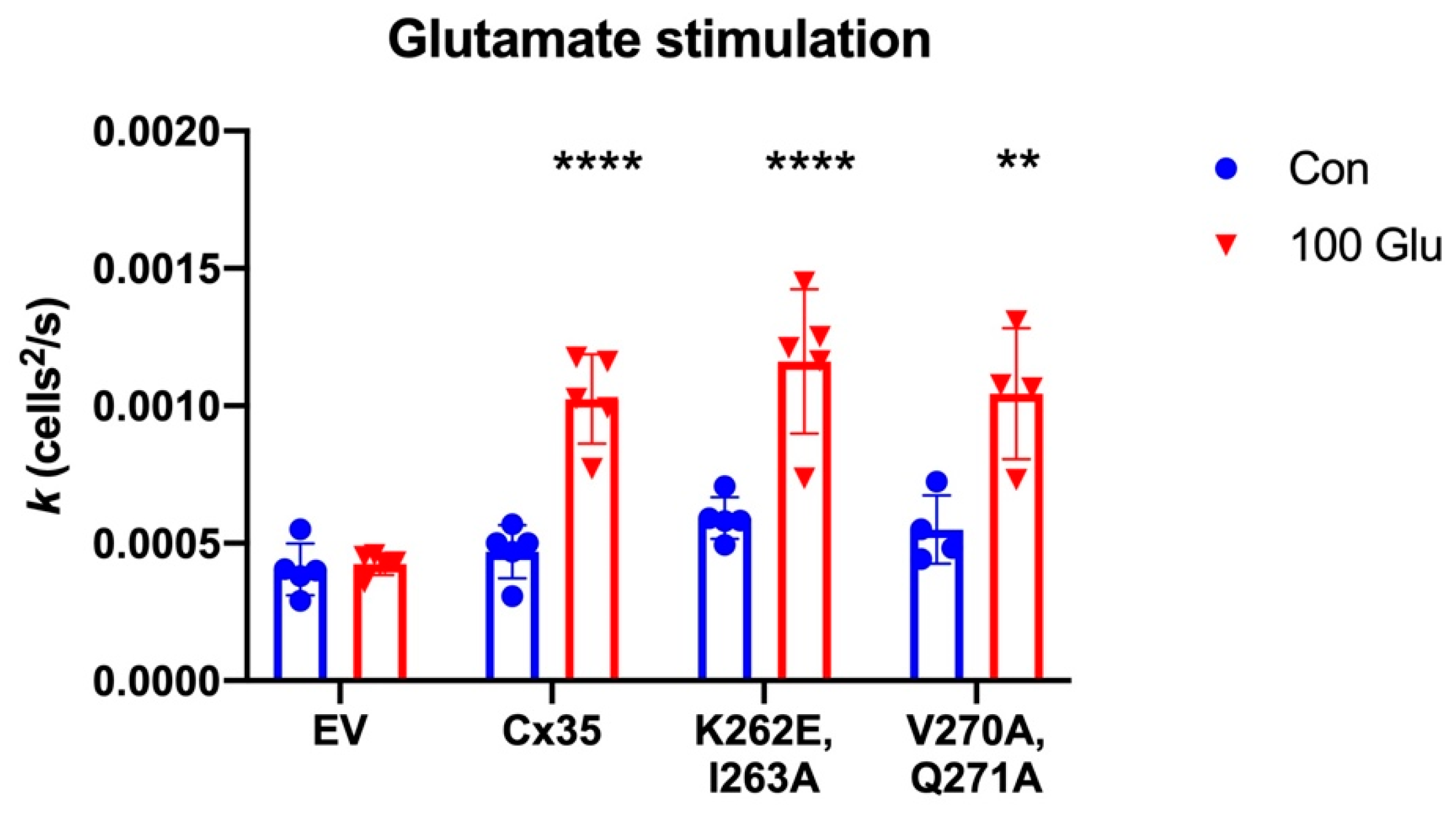

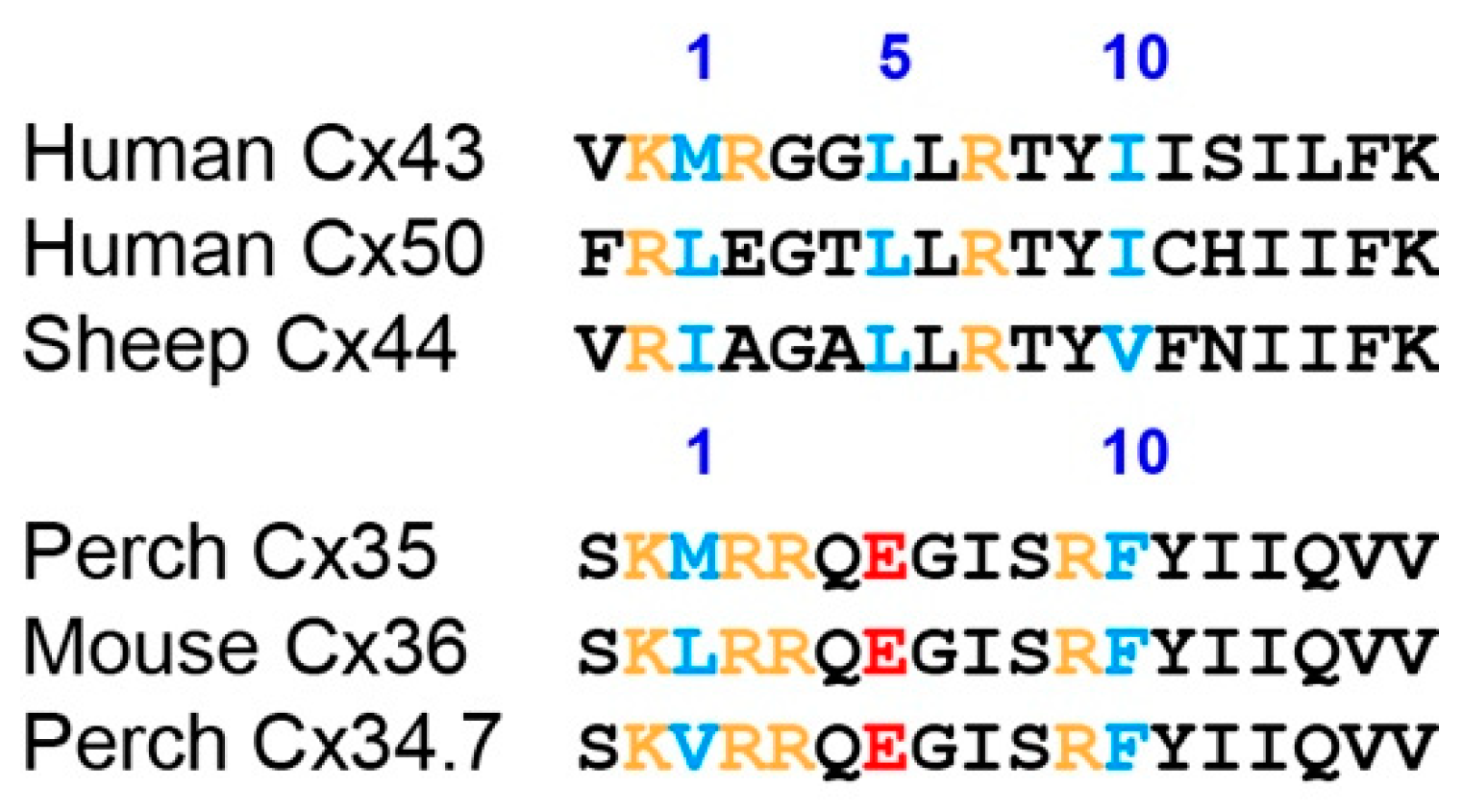
© 2020 by the authors. Licensee MDPI, Basel, Switzerland. This article is an open access article distributed under the terms and conditions of the Creative Commons Attribution (CC BY) license (http://creativecommons.org/licenses/by/4.0/).
Share and Cite
Aseervatham, J.; Li, X.; Mitchell, C.K.; Lin, Y.-P.; Heidelberger, R.; O’Brien, J. Calmodulin Binding to Connexin 35: Specializations to Function as an Electrical Synapse. Int. J. Mol. Sci. 2020, 21, 6346. https://doi.org/10.3390/ijms21176346
Aseervatham J, Li X, Mitchell CK, Lin Y-P, Heidelberger R, O’Brien J. Calmodulin Binding to Connexin 35: Specializations to Function as an Electrical Synapse. International Journal of Molecular Sciences. 2020; 21(17):6346. https://doi.org/10.3390/ijms21176346
Chicago/Turabian StyleAseervatham, Jaya, Xiaofan Li, Cheryl K. Mitchell, Ya-Ping Lin, Ruth Heidelberger, and John O’Brien. 2020. "Calmodulin Binding to Connexin 35: Specializations to Function as an Electrical Synapse" International Journal of Molecular Sciences 21, no. 17: 6346. https://doi.org/10.3390/ijms21176346
APA StyleAseervatham, J., Li, X., Mitchell, C. K., Lin, Y.-P., Heidelberger, R., & O’Brien, J. (2020). Calmodulin Binding to Connexin 35: Specializations to Function as an Electrical Synapse. International Journal of Molecular Sciences, 21(17), 6346. https://doi.org/10.3390/ijms21176346





